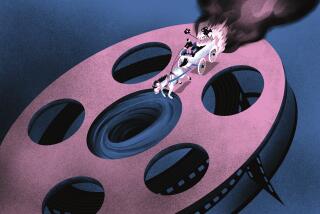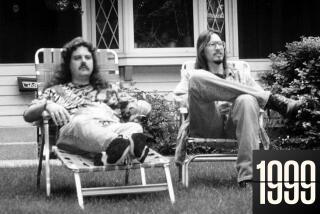‘Meek’s Cutoff’: A starkly different kind of western
- Share via
After a hand-stitched title card announces the year and place as 1845 Oregon, “Meek’s Cutoff” shows the slow, laborious process of a small wagon train moving across open country. A river is crossed, water gathered, clothes wrung out, cookware scrubbed. Then, as one shot dissolves slowly into another, one barren landscape fading in from the last, the wagons and their guide seem to roll right across an expanse of open sky, an image at once rustic, fragile and mystical. “Meek’s Cutoff” is by all technical definitions a western but also clearly something more.
The film, which opens in Los Angeles on Friday, is based on the historical story of a wagon train that lost its way while on the Oregon Trail. The hundreds of wagons from the real adventure are here pared to those belonging to just three families — the wealthy Gatelys (Zoe Kazan, Paul Dano), the religious Whites (Shirley Henderson, Neal Huff, Tommy Nelson) and the stalwart Tetherows (Michelle Williams, Will Patton). Once they all find themselves lost in a desert, unsure which way to head for the nearest water, their guide, Stephen Meek (Bruce Greenwood), struggles to assert his authority even before they come across a Native American (Rod Rondeaux) who may or may not be inclined to help them. The settlers face the tough decision of whether to follow Meek, the Indian or strike out on their own.
Even as director Kelly Reichardt maintains a regular job teaching film at Bard College in Annandale-on-Hudson, N.Y., juggling publicity duties around her class schedule and taking a semester off for production, she has become a widely celebrated independent filmmaker of works noted for their spare vibrancy. “Meek’s Cutoff,” being distributed by Oscilloscope Laboratories, is the third film by Reichardt to be set in the Pacific Northwest, all written in collaboration with Jon Raymond. The pair were introduced by a mutual friend, filmmaker Todd Haynes. (Raymond also worked on the adaptation of Haynes’ recent HBO miniseries, “Mildred Pierce.”)
It was Raymond who first came across the story of Stephen Meek and his ill-fated wagon train. The duo soon began researching the journey, coming across not only Meek’s own self-aggrandizing account of the trip but also numerous journals kept by emigrants on the rough crossing out West. “The journals are so contradictory to one another it’s hard to imagine these people were even on the same trip,” Reichardt said during a recent phone call from New York. “But I guess you travel in your own world and you have your own perspective.”
“For me, one of the main interesting things that comes out of the diaries is the question among the pioneers as to whether Stephen Meek is evil or just stupid,” Raymond said from his home in Portland, Ore. “That was an actual debate among the pioneers.”
In some ways, the difficulties portrayed in the film were mirrored by the production itself in moving cast, crew, equipment, wagons and animals to the remote parts of eastern Oregon traversed by the historic settlers. It took two hours each way every day to get to the locations. Bodies of water scouted for a river crossing would be bone dry by the time the production was ready to shoot the scene, and like the original wagon train, they would have to move on in search of more water.
“For a film company, we left a pretty small footprint,” Greenwood said of how the making of the movie could feel much like the travails of the wagon train itself. “There weren’t that many people scrambling around, so it did feel like a small group against the elements.”
Before filming, the actors all took part in a pioneer camp where they learned how to start a fire, work a coffee grinder, pitch a tent, lead oxen and a variety of other tasks they would be performing while re-creating life on the wagon train. In something like an action scene, more than a full minute of screen time is given over to watching Williams load, fire, reload and again fire a rifle as a call for the men to come back from their search for water after she first spots the lone Native American scout.
That sense of process, the daily details of migrants making their way across the country with only basic tools and their own sense of purpose, was one thing that intrigued Reichardt while making the film. The reality stood in stark distinction from the action-heroics of a typical gun-slinging western.
“I just remember going through those first journals and thinking how different the whole tone of the going West story was, compared to what the film genre gives you,” added Reichardt. “The women’s journals were so trance-like, the opposite of the continuous climactic moment that westerns bring. The days and the landscape just become one.
“What is it like to wake up and walk all day, day after day, for months until you’ve gone across the entire country? That’s really what it is, time taking on this different kind of tension than westerns have, that comes from the absence of these events. The journals start out very romantic, with lots of poetic imagery, and then become stripped down to just these lists of chores.”
Reichardt’s films with Raymond sneakily operate on multiple levels. One could easily think of “Wendy and Lucy” as being just about a transient young woman and her lost dog or about the struggles of the working poor in contemporary America. In the same way, “Meek’s Cutoff” is a revisionist western richly layered to consider the emergence of women’s role in society, divisions of class and a nascent concern for native peoples as well as a bracing parable of what happens when one enters a desert with an uncertain leader. Or it can be seen as a film about people trudging ahead.
Reichardt, 46, who’s originally from Miami, has an air of quiet self-possession. It is apparent that she is extremely serious about her work and yet she often seems remarkably casual when discussing it. Often, the actors don’t know all the layers of the story Reichardt is trying to tell because she keeps them focused only on details specific to their characters.
“By this time, I’m kind of hip to her subterfuge,” said Williams, who also starred in “Wendy and Lucy.” “One of the things I love so much about the process of working with her is when I actually get to see the movie and see what she’s been up to, that I had no idea about. Both times, after watching the movie, my first response is to marvel at what Kelly was up to, secretly and invisibly, without any of us knowing.”
Reichardt and Raymond are already at work crafting another project together, though it is still too early, she says, to talk about. She admits that in the case of “Meek’s Cutoff,” the practical struggles of the production often made her diffuse methods seem that much more frustrating or confusing for the actors, even as she worked to keep each of them sharply centered on the immediate details of the story and herself on the broader horizon.
“I guess some of it is just protecting yourself,” she said, “being able to find new answers as you’re shooting. I think that’s really the hardest part of filmmaking: You have to super-plan when you go in, but you know elements are going to introduce other things to you on the day you’re shooting, the weather, the camera can’t move through this patch of sage, whatever it is.
“I’m definitely not into winging it, but there is something to being able to discover while I’m making it and trying to protect that is part of why I can be private about what I’m doing. I want to be able to hear my voice and focus and tune in on it with all that’s going on.”
More to Read
The biggest entertainment stories
Get our big stories about Hollywood, film, television, music, arts, culture and more right in your inbox as soon as they publish.
You may occasionally receive promotional content from the Los Angeles Times.










